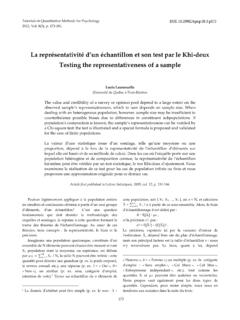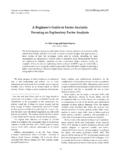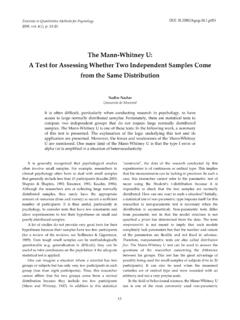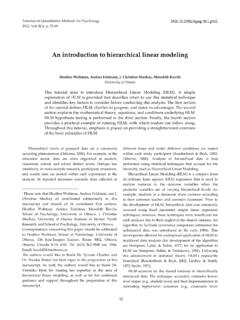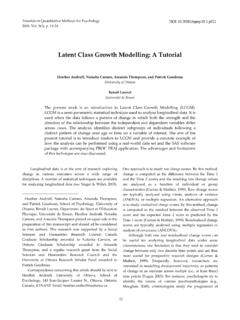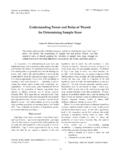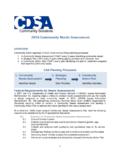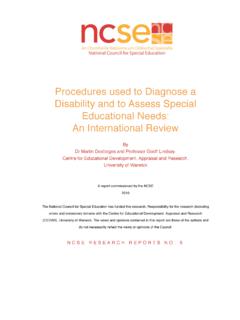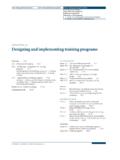Transcription of A Practical Tutorial on Conducting Meta-Analysis in R
1 2015 vol. 11 no. 1 TTTThe QQQQ uantitative MMMM ethods for PPPP sychology T Q M P 37 A Practical Tutorial on Conducting Meta-Analysis in R A. C. Del Re , a a Center for Innovation to Implementation, VA Palo Alto Health Care System, USA AbstractAbstractAbstractAbstract Meta-Analysis is a set of statistical procedures used for providing transparent, objective, and replicable summaries of research findings. This Tutorial demonstrates the most common procedures on Conducting a Meta-Analysis using the R statistical software program.
2 It begins with an introduction to Meta-Analysis along with detailing the preliminary steps involved in completing a research synthesis. Then, a step-by-step Tutorial for each of the quantitative components involved for Meta-Analysis is provided using a fictional set of psychotherapy treatment-control studies as a running example. Keywords Keywords Keywords Keywords Meta-Analysis , R, Tutorial , effect sizes IntroductionIntroductionIntroductionIntr oduction Gene Glass (1976) introduced the term Meta-Analysis to refer to the statistical analysis of a large collection of analysis results from individual studies for the purpose of integrating the findings (p.)
3 3). As with any statistical procedure, Meta-Analysis has its strengths and limitations (see Table 1), but is now one of the standard tools for providing transparent, objective, and replicable summaries of research findings in the social sciences, medicine, education, and other fields (Hunter & Schmidt, 2004; Hunt, 1997). This Tutorial provides a step-by-step demonstration of the fundamentals for Conducting a Meta-Analysis (summarized in Table 2) in R (R Core team , 2013).
4 The user should download and install R version (or greater) to ensure replicability of each step in this Tutorial . Several R packages for Meta-Analysis will be used (freely available), including ( Del Re, 2010) for computing effect sizes and MAd (Del Re & Hoyt, 2010) and metafor (Viechtbauer, 2010) for aggregating effect sizes, Conducting omnibus, meta-regression, and graphics. MAd provides a convenience wrapper for omnibus and meta-regression functionalities that are available in the metafor R package (Viechtbauer, 2010).
5 R is an open-source statistical software program for data manipulation, graphics, and statistical analysis . R can be downloaded freely at . Systematic research strategies At the start of a meta-analytic endeavor, research questions needs to be formulated with precision, as these questions will affect the entire meta-analytic process. Then, as is usual in any empirical or experimental investigation, inclusion and exclusion criteria must be detailed.
6 This will provide clarity on how the study results may generalize to the population. One of the goals of every Meta-Analysis is to gather a representative sample of primary studies that meet the study criteria. A systematic research strategy consists of two major steps: (1) defining inclusion and exclusion criteria and (2) selecting studies. (1) Inclusion and (1) Inclusion and (1) Inclusion and (1) Inclusion and exclusion criteria. Defining study inclusion and exclusion criteria should be based on the study s hypotheses and research questions (see Table 3 for examples).
7 Inclusion/exclusion criteria could potentially bias the study results. Therefore, it is important to be as explicit and thoughtful as possible when defining these criteria. (2) Study selection.(2) Study selection.(2) Study selection.(2) Study selection. Study selection and the data extraction process are often the most time-consuming steps in Conducting a Meta-Analysis . The study selection process usually follows a particular sequence from the initial search to the coding of effect sizes from the single primary studies.
8 It can be helpful to structure the study selection process based on the 4 steps (study identification, screening, eligibility and inclusion) detailed in the Meta-Analysis Reporting Standards (MARS) guidelines ( ) or the PRISMA statement (see ). The above steps should be double coded by two (or more) collaborators to ensure greater objectivity and 2015 vol. 11 no. 1 TTTThe QQQQ uantitative MMMM ethods for PPPP sychology T Q M P 38 precision of the study selection process.
9 Extracting study-level information and generating reliability statistics Study characteristics ( , average number of sessions in the study) and relevant data to calculate effect sizes should be extracted from each of the included primary studies. Most studies will report more than outcome measure to calculate an effect size. For each study, ensure that the coded effect sizes from a single sample have the same study ID. The data extracted from the primary studies should be double-coded and checked for the degree to which the two or more coders are in agreement.
10 Double coding is used to determine the degree to which coding errors are present ( , reliability), which could subsequently bias the meta-analytic findings. The double coded data should be assessed with interclass correlation procedures for continuous variables ( , number of treatment sessions) and Kappa coefficients for categorical variables ( severity of participant distress, coded as low or high ). Sample data After the raw dataset is constructed and adequate reliability is obtained for each variable, analyses can begin.
